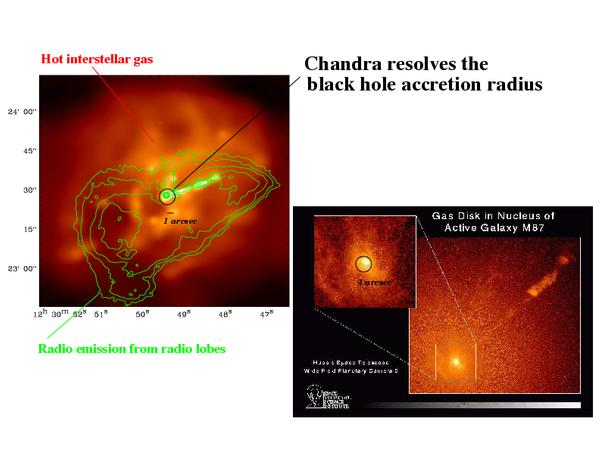M87: Viewing the Black Hole Feeding |
|
Scientists at the Max-Planck Institute for Astrophysics and their collaborators have used the Chandra X-ray satellite to unveil the gravitational capture radius of the the black hole in M87. They have measured the matter density and temperature at this radius and calculated the rate at which matter is fed into its central black hole.
It is now well established that black holes exist in the centers of most galaxies. The black hole in the center of the galaxy M87, located 50 million light-years away in the constellation of Virgo, is the largest nearby black hole. It weighs more than a billion suns, and is concentrated into a region no larger than our Solar System. The mass was measured with the Hubble Space Telescope which revealed a disk of rapidly rotating, hot gas with a central black hole at its hub.

|
| Figure 1: On the left is the Chandra X-ray light coming from the central supermassive black hole in the core of the galaxy M87 (yellow) and from the hot interstellar gas in the galaxy (red). The X-ray light peaks at the position of the black hole. The luminosity of the X-ray light is much lower than expected from standard, efficient black-hole accretion theory. The black circle in the center indicates the position at the black hole capture radius where gas temperature and density have been measured. On the right a NASA Hubble Space Telescope image of the galaxy has previously revealed a disk of rapidly rotating, hot gas with a central black hole at its hub. A brilliant jet of high-speed electrons emitted from the nucleus of M87 (diagonal feature across the images) is also thought to be produced by the black-hole "engine". The brightest spots in this jet are also emitting X-ray light (and radio emission; as shown by the green contours). |
While supermassive black holes in the distant Universe generate huge luminosities (in phenomena known as quasars) the vast majority of supermassive black holes in our vicinity are extremely dim. M87 is perhaps the most illustrative case of a dim supermassive black hole. The luminosity from a black hole is produced by matter falling into a black hole through what is known as an accretion disk.
Typically, a supermassive black hole in a galaxy such as M87, can capture the interstellar gas out to distances 10000 times its radius. Thanks to its unprecedented sensitivity and resolution the Chandra X-ray Satellite has shown the location at which the gas is being pulled in towards the black hole. This has allowed scientists to measure the rate at which matter falls in from this region. These new results show that the black hole in M87 is feeding on gas at a sufficiently high rate that it should display a much larger luminosity than what is observed. This suggests that nearby black holes are not dim because they are starved of fuel but rather, because their accretion disks are inefficient at converting mass into energy.
Tiziana Di Matteo
Further information:
| MPA-Home |